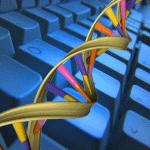Bioinformatics
|
11 october 2017 10:27:40 |
| Computational characterization of substrate and product specificities, and functionality of SAM binding pocket in histone lysine methyltransferases from Arabidopsis, rice and maize (Proteins: Structure, Function, and Bioinformatics) |
|
Tweet Histone lysine methylation by histone lysine methyltransferases (HKMTs) has been implicated in regulation of gene expression. While significant progress has been made to understand the roles and mechanisms of animal HKMT functions, only a few plant HKMTs are functionally characterized. To unravel histone substrate specificity, degree of methylation and catalytic activity, we analysed ATX, SUVH, SUVR, ATXR5, ATXR6, and E(Z) HKMTs of Arabidopsis, maize and rice through sequence and structure comparison. We show that ATXs may exhibit methyltransferase specificity towards histone 3 lysine 4 (H3K4) and might catalyse the tri-methylation. Our analyses also indicate that most SUVH proteins of Arabidopsis may bind histone H3 lysine 9 (H3K9). We also predict that SUVH7, SUVH8, SUVR1, SUVR3, ZmSET20 and ZmSET22 catalyse mono- or di-methylation of H3K9. Except for SDG728, which may tri-methylate H3K9, all SUVH paralogues in rice may catalyse mono- or di-methylation. ZmSET11, ZmSET31, SDG713, SDG715 and SDG726 proteins are predicted to be catalytically inactive because of an incomplete SAM binding pocket and a post-SET domain. E(Z) homologues can tri-methylate H3K27 substrate, which is similar to the EZH2 of humans. Our comparative sequence analyses reveal that ATXR5 and ATXR6 lack motifs/domains required for protein-protein interaction and PRC2 complex formation. We propose that subtle variations of key residues at substrate or SAM binding pocket, around the catalytic pocket, or presence of pre- and post-SET domains in HKMTs of the aforementioned plant species lead to variations in class-specific HKMT functions and further determine their substrate specificity, the degree of methylation and catalytic activity. This article is protected by copyright. All rights reserved. |
| 197 viewsCategory: Biochemistry, Bioinformatics |
 Crystal structure of d-glycero-?-d-manno-heptose-1-phosphate adenylyltransferase from Burkholderia pseudomallei (Proteins: Structure, Function, and Bioinformatics) Crystal structure of d-glycero-?-d-manno-heptose-1-phosphate adenylyltransferase from Burkholderia pseudomallei (Proteins: Structure, Function, and Bioinformatics)Molecular dynamics simulation, binding free energy calculation and unbinding pathway analysis on selectivity difference between FKBP51 and FKBP52: Insight into the molecular mechanism of isoform selectivity (Proteins: Structure, Function, and Bioinformatics) 
|
| blog comments powered by Disqus |
MyJournals.org
The latest issues of all your favorite science journals on one page
The latest issues of all your favorite science journals on one page



